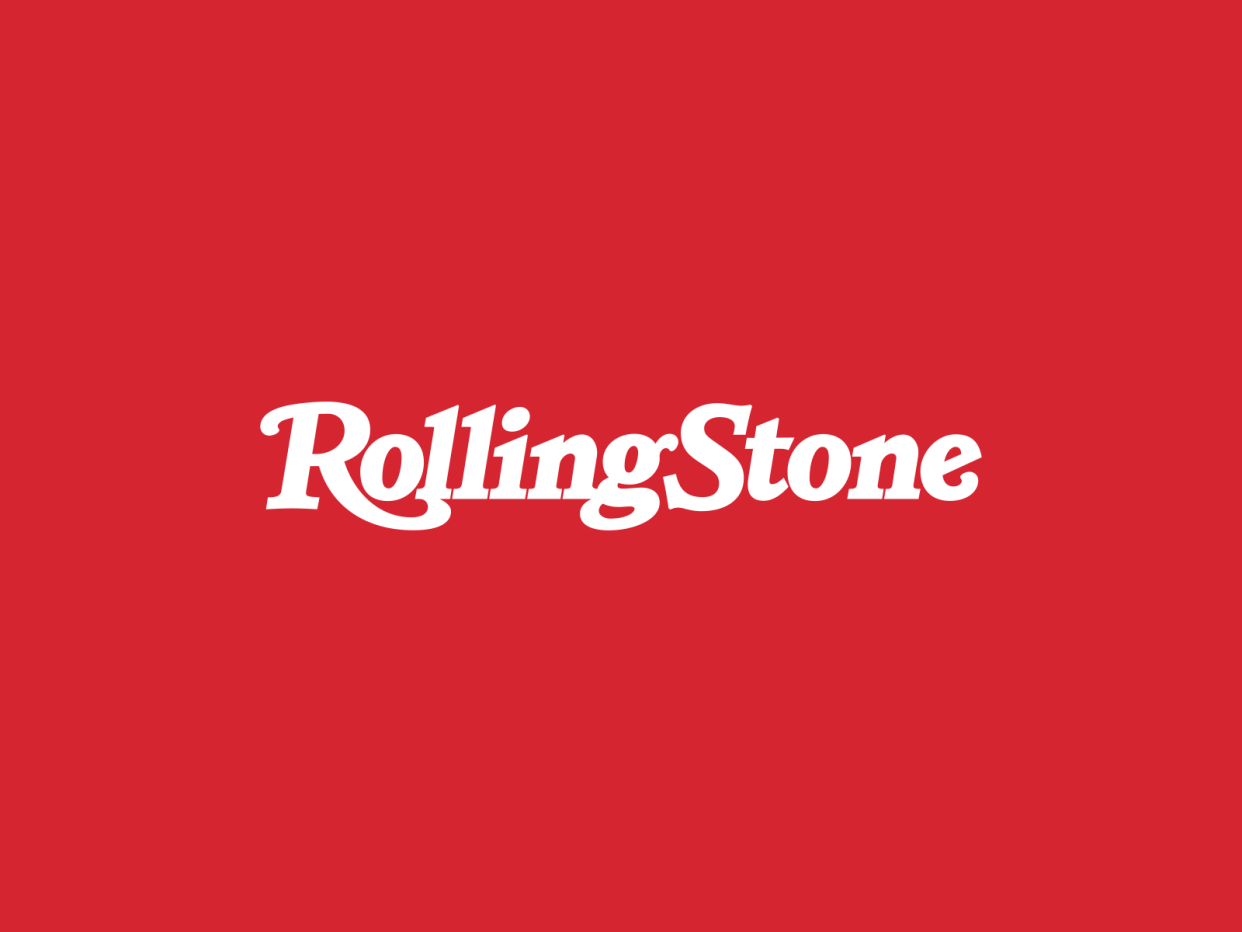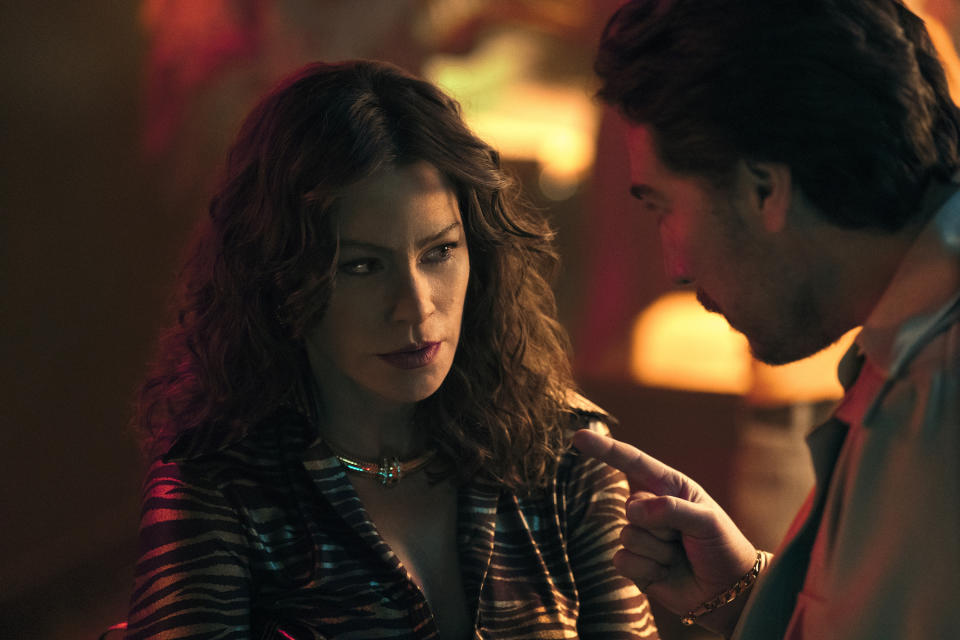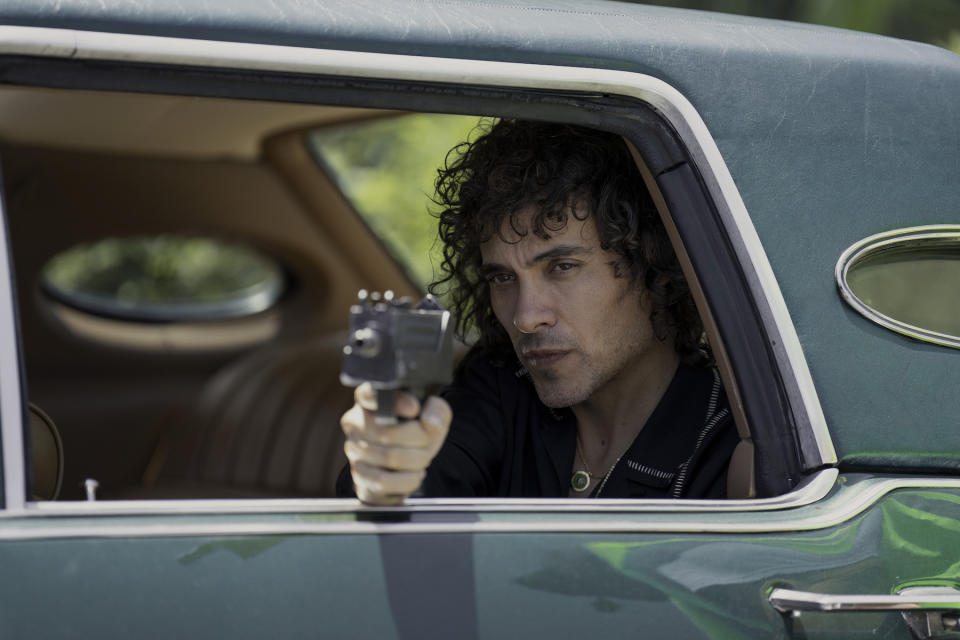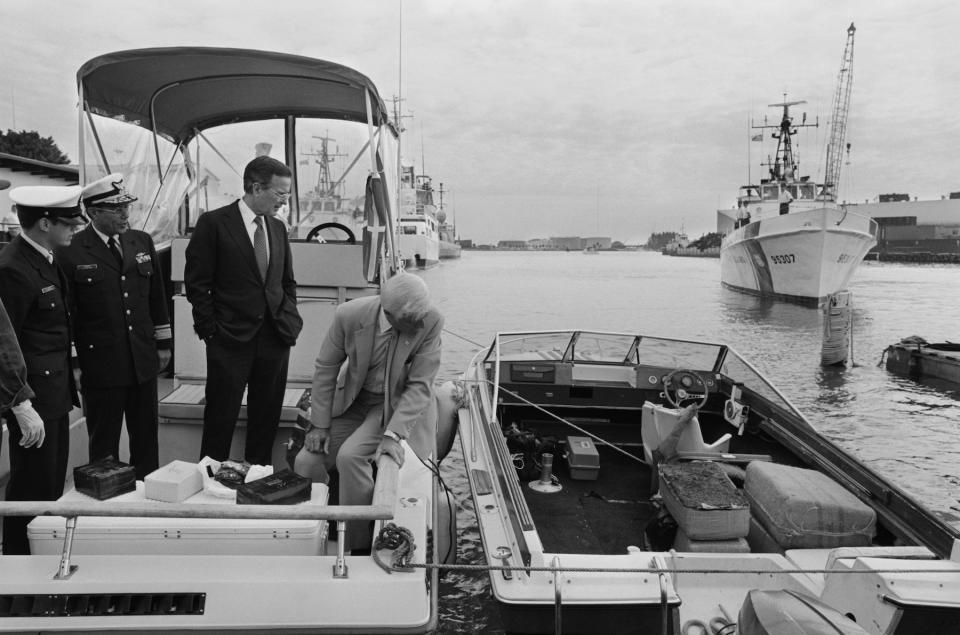The True Story of Griselda Blanco, Deadly ‘Cocaine Godmother’ of Miami

- Oops!Something went wrong.Please try again later.
- Oops!Something went wrong.Please try again later.
Most remember Griselda Blanco as the “Black Widow,” a ruthless Colombian drug lord whose network flooded Miami with cocaine, brought in $80 million a month nationally, and who’s been personally implicated in a rumored 200 murders. Michael Corleone Blanco, her youngest son raised at the height of her drug-trafficking empire, admits she was a rigid, stern woman he affectionately called cariñosa — an endearing term given to loved ones.
“As a kid, you can’t really comprehend what is wrong, what is right, and what is the family business,” Blanco tells Rolling Stone. “So, since I grew up with that day-to-day lifestyle — having security, always being aware of my surroundings, always knowing that there was a certain element of danger — when you’re young, you really don’t start to understand.”
More from Rolling Stone
How One Lonely Man's Online Date Turned Into a Bloody Nightmare
Harmony Korine's Strip Club Movie Premiere Was All Ass, No Gas
As his mother’s cocaine fiefdom racked in around $2.6 million a day at its height, Blanco soaked up the luxury lifestyle. His three older brothers, who were all murdered, drove Lamborghinis, Ferraris, and Maseratis, with one brother customizing his luxury sports cars to his height. They traveled in armed vehicles to their palatial homes in Key Biscayne and Palm Island and owned a private jet. For his sixth birthday, his family rented out a cruise ship with a petting zoo, not long before his mother’s arrest in 1985 for cocaine trafficking.
“The villains of some become heroes with others and that’s what my mother was,” Blanco says. “She did bad things, I know that, but she was my mother and I love her.”
His mother’s blood-soaked reign in the Seventies and Eighties is the subject of Netflix’s Griselda, a six-part series starring Modern Family’s Sofía Vergara as the cutthroat queenpin. Created by Ingrid Escajeda and Narcos vets Eric Newman, Doug Miro, and Carlo Bernard, the miniseries follows Griselda as she arrives in Miami with her three sons (including a young Blanco, played by Benson D. Larracuente in the latter episodes) and a kilo of cocaine with aspirations to establish a thriving cocaine-trafficking network between her native Colombia and Miami. As Griselda prowls Miami nightclubs and suburban enclaves for affluent customers, she butts heads with ruthless cartel bosses and the Miami PD, led by June Hawkins (Juliana Aidén Martinez). Although filmed in L.A., the Andrés Baiz-directed show depicts an era in the South Florida city when cocaine was king and Griselda-linked drug wars made national headlines.

Blanco had previously made appearances in a number of documentaries and TV movies, including Cocaine Cowboys and Lifetime’s Cocaine Godmother, where she was played by Catherine Zeta Jones. She’s also been depicted as a folk hero of sorts on a number of rap songs, such as Lil Kim’s “Warning Freestyle” and Meek Mill’s “Believe It.” And the series has proven to be a massive hit for Netflix, debuting at No. 1 in 90 countries. The show’s announcement prompted Michael Corleone Blanco to file a lawsuit against Netflix, Vergara, and the producers of Griselda, alleging the series stole his “private artistic literary work” and will cause “irreparable injury” and “damage his reputation in the entertainment community.”
Prior to the show’s release, he criticized the series’ decision to transform Vergara into his mother by using a prosthetic nose, fake teeth, and pads to flatten her figure, telling the Daily Mail that Blanco “was a beautiful woman and it’s crazy that a lot of people say, “No, you’ve got to look more like a drug addict.” His feelings on the matter have since changed.
“I admire [Vergara] for what she’s done and I admire her for even taking that leap of faith to try to play my mother,” Blanco shares, adding that he’s unable to comment on the lawsuit. “That’s respectable in itself.”
He also claims to have spent several years “meticulously documenting the private narratives of his, as well as his mother’s life,” with the aim of publishing a book and developing a Spanish soap opera. On Feb. 7, a federal judge returned the lawsuit to a Miami-Dade County court and requested further clarification on Blanco’s allegations as they were “at times, contradictory.” The case was dismissed on Feb. 9.
“This matter is no longer pending,” Blanco’s lawyer Elysa Galloway wrote in a statement to Rolling Stone.
When former Washington Post editor Jeff Leen arrived in Miami in 1985, Blanco had already left for California to escape her rivals and impending drug charges. But her shadow still engulfed the city and her murderous legacy was beginning to be memorialized in drug-war thrillers like Scarface and Miami Vice.
In the late 1970s, the Miami suburbs of Kendall and Coral Gables consisted of manicured lawns, Spanish architecture, and hard-partying white-collar workers with plenty of disposable cash. Cocaine became the party drug of choice, and Blanco serviced this well-to-do gringo clientele, says Leen, the co-author of Kings of Cocaine: Inside the Medellín Cartel. After watching the series, which Netflix describes as a “lethal blend of unsuspected savagery and charm,” Leen believes it got certain things right but should be taken with a heavy grain of salt.
“In my opinion, Griselda was a stone-cold sociopath, and I don’t buy the fact that she was doing this out of a sense of motherly love for her children or that she was forced into killing in a reluctant way,” Leen tells Rolling Stone. “She was a stone-cold killer from before she was a teenager in Colombia.”
As a teenager, Blanco ran away from home to escape her mother’s abuse, resorting to pickpocketing to survive on the streets of Medellín. She got into marijuana-trafficking with her first husband, Carlos Trujillo, before divorcing him and moving to Queens, New York, in the 1960s. She was introduced to the world of cocaine trafficking through her second husband, Alberto Bravo, a cocaine smuggler for the Medellín Cartel, and the two set up a cocaine business in New York City. During a DEA/NYPD investigation dubbed “Operation Banshee,” 150 kilos of cocaine that were going to be moved by the couple were intercepted. And in April 1975, Blanco and Bravo — along with their crew — were hit with drug-trafficking charges, but fled to Colombia before the authorities could get to them. Shortly thereafter, Blanco shot Bravo in the head and killed him after believing he stole millions from their drug business.
She was henceforth known as the “Black Widow.”
Blanco continued to run a cocaine operation out of Colombia for several years, married bank robber Dario Sepulveda in 1978 — their son, Michael Corleone Blanco, was named after Al Pacino’s character in The Godfather — and around that time, started smuggling cocaine into Miami in brazen fashion, eventually setting up shop there. According to Billy Corben in a 2012 NPR interview, the director of Cocaine Cowboys, “She smuggled in at least six kilos of cocaine on the tall ship Gloria, which the Colombian government had sent to Miami eventually to participate in a race to New York Harbor to celebrate America’s Bicentennial.”
She soon earned a reputation as one of the best-known cocaine smugglers in the United States. The real Blanco was five-foot-two with dimples, which helped her earn another, friendlier nickname: “Dollface.” Although it was estimated that Blanco had several hundred people on her payroll, she liked to work with women and had ties to a Medellín lingerie shop that manufactured pockets in bras and girdles so her mules could carry kilos of cocaine in them, as depicted in the series.
In order to gain membership in her gang, Los Pistoleros, you had to murder someone and produce a severed ear or finger as proof. One Pistolero taped the eyes and mouth of his victims, draining their blood in bathtubs, while another was known for wiping out people by firing a machine gun from the back of a motorcycle. Blanco would later be credited for creating the “motorcycle assassin” (more on this later).
It was almost this subterranean sense of fear and dread that there was this very dangerous, very lucrative industry taking place just beneath the surface of everything you saw in sunny, beautiful Miami.
“It was almost this subterranean sense of fear and dread that there was this very dangerous, very lucrative industry taking place just beneath the surface of everything you saw in sunny, beautiful Miami,” Leen says.
A quote that kicks off the series by drug lord Pablo Escobar captures Blanco’s reign of terror: “The only man I was ever afraid of was a woman named Griselda Blanco.” Escobar and Blanco were contemporaries, with Escobar’s Medellín Cartel gaining traction in Hollywood before exploding in Miami in the late 1970s, eventually controlling more than 50% of the cocaine-trafficking trade in the U.S. by the mid-1980s.
“Her empire was a subset of the cartel’s operations in South Florida, which had a dozen other arms,” explains Leen. “So she was one arm, but she was most prominent because of Dadeland and her role in all these murders. So, her bloodthirsty connection to these murders gave her more of a reputation than her actually moving the coke.”
In 1979, Blanco was linked to a deadly shootout at Dadeland Mall, the largest shopping center in South Florida at the time. As Leen wrote in Kings of Cocaine, two Colombian cocaine dealers — in broad daylight — opened fire on another dealer and his bodyguard at a liquor store. Two men died, and the shooting branded Miami home of the “cocaine cowboys” in national media coverage.
“It had an impact that outweighed the fact that only two people were killed,” Leen says. “It was seared into our memory. It drove all this fear. It created an image of the Colombian cocaine killers that lasts to this day.”
The Dadeland shooting was the first time Al Singleton, a retired homicide detective, had heard of Blanco. The Miami PD received knowledge from the DEA that Blanco may have been involved. As he arrived on the scene, Singleton, who was portrayed in the final episodes of the series by Carter MacIntyre, was struck by the sheer amount of cavalry left in the shooters’ war wagon: MAC-10s, carbines, shotguns, and pistols.
“That was a stark realization of how outgunned we were because back then, the only weapon we were allowed to carry was a six-shot .38-caliber revolver,” Singleton tells Rolling Stone.
Three years later, Blanco ordered the murder of Jesus “Chucho” Castro, a former enforcer, that led to the drive-by death of his 2-year-old son, Johnny Castro. In the series, Griselda appears distressed when learning of the toddler’s death, but the real-life Blanco was far less forgiving.
“Griselda showed her a little bit empathetic toward her victims, and you can rest assured, she showed no empathy toward any victims — and that includes 2-year-old Johnny Castro,” Singleton maintains, adding, “She was upset because they missed Chucho but then she was happy because knowing that his son was killed, he would suffer.”

Nelson Andreu, a former Miami Homicide detective, was used to bar-fight deaths, jealous husband-slayings, and nickel-and-dime drug deals turned deadly. But the murders and drug-related violence associated with Blanco and the Medellín Cartel was something he and his fellow officers weren’t equipped for.
“[It was] the worst times for the police department because neither the city of Miami or Miami-Dade County were prepared,” Andreu offers. “Hialeah, Coral Gables, Miami Beach all the homicide units were not prepared to handle what was thrown our way. We didn’t have enough manpower.”
As one of the few Spanish-speaking detectives on the force at the time, Andreu responded to the homicide call for 2-year-old Johnny Castro, and ultimately helped on the case that led to Blanco’s conviction on second-degree murder charges in the child’s death.
“What we saw with Griselda and her people was something that was unprecedented…and hasn’t happened since and probably won’t happen again if we’re lucky,” Andreu says.
At the time, South Florida was a prime location for “conversion laboratories,” where cocaine was converted from its base form to cocaine hydrochloride (HCl), the white, crystalline powder that’s sold. The crack epidemic soon followed, and by 1985, there were 5.8 million regular cocaine users across the country, according to the Department of Health and Human Service’s National Household survey. Cocaine-related hospital emergencies were on the rise, too.
Ned Edwards, a South Florida resident who manages a non-profit, remembers watching drug-related killings, including the Dadeland Mall shooting, on the news as a teenager. He and his friends tried cocaine for the first time during high school. Edwards later spiraled into addiction in the mid-1980s and faced homelessness before eventually getting clean in the early 2000s.
“It became a war zone, but the drug sales didn’t stop,” Edwards says. “So if you were addicted, you didn’t care.”
Blanco ultimately spent close to two decades behind bars for drug trafficking and three murders — the other two involving drug dealers Alfredo and Grizel Lorenzo, who were assassinated in their Miami home as their children watched TV in a neighboring room. Blanco allegedly delivered five kilos of cocaine worth $250,000 and the two had failed to pay up. After her release from prison, she was deported to Colombia in 2004 and became a born-again Christian. While exiting a butcher shop in 2012, a gunman on a motorcycle drove by and put two bullets in Blanco’s head, executing her in the style she’d made popular. She was 69.

At the “Cocaine Godmother’s” height, Miami was the murder capital of America with more than 500 homicides in 1980. Last year, Miami reported 31.
Blanco’s only surviving son, Michael Corleone Blanco, lost 22 family members to the drug wars. He was there when his own father, Dario Sepulveda, was assassinated in 1983 while in Colombia. After that, Corleone Blanco was raised by a series of legal guardians while his mother and brothers were behind bars. When he visited his mom at a New York federal correctional facility in the mid-1980s, she told him that she was attending university. But his legal guardian at the time told him the truth.
“I kind of understood what the family business was, but it took a third party to tell me, ‘Oh, don’t think it’s good — you’re part of a mafia family, a cartel family,’” Corleone Blanco recalls. “That’s when I had my first rude awakening to it as, I’m visiting my mother [in prison].”
He was arrested on two felony counts of cocaine trafficking and conspiracy to traffic cocaine in 2011 after trying to buy five kilos from an undercover detective, Miami New Times reported. He was on house arrest when his mother was killed, and his probation ended in 2018.
Corleone Blanco now runs the clothing brand Puro Blanco and is the author of My Mother, The Godmother, and the True Story of Michael Corleone Blanco. Reflecting on his mother’s legacy, he says he wants to turn the page and provide a safe environment to raise his three children.
“Miamians have been so affected from the 1970s and ‘80s cocaine cowboy wars and the crack epidemic, and I’m one of the only Blancos here that can ask for apologies on my family’s behalf,” Corleone Blanco says. “I apologize to everybody that was directly affected.”
Best of Rolling Stone

